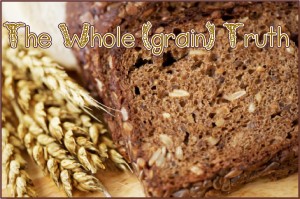Man does not live by bread alone, or so we’ve been told. There are so many breads that are just down right awful and lead to inflammation and sluggish digestion. You know the ones I’m talking about. Specifically, white bread. Kids love white bread (remember squishing those white slices into a cube of dough?) Even if you ate white bread as a kid and you’re convinced your child will only eat white bread, we’re going to try and break that white bread habit.

We start by reading labels. It can be deceptive! There is a HUGE difference between “whole wheat” and “wheat flour.” I know it’s hard to tell when you’re walking down the bread isle and every other label is marked with one or the other and eventually they all start to blur together and start sounding the same. That word “whole” is important–that’s the word to look for.
Whole wheat flour contains the entire grain (even the bran, germ, and endosperm). Plain wheat flour doesn’t have the bran or germ, leaving you with fewer nutrients. Don’t be fooled by “enriched” wheat flour either! Another little trick in labels. Enriched only means whatever nutrients that were lost in the processing are added back, but it still doesn’t have the bran or germ.
You always want to check the ingredients to ensure that you’re buying bread that is using whole grain wheat. Even if some packaging says “made with whole grains” it’s not necessarily made with whole grain flour. I know it’s confusing! To recap: you want the word “whole”. Double check the ingredients and make sure one of the first ones listed is whole wheat/grain flour! (and obviously, if there is hydrogenated anything in there, leave that bread on the shelf too!)